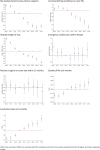Mixed methods evaluation of the Getting it Right First Time programme in elective orthopaedic surgery in England: an analysis from the National Joint Registry and Hospital Episode Statistics
- PMID: 35710256
- PMCID: PMC9207914
- DOI: 10.1136/bmjopen-2021-058316
Mixed methods evaluation of the Getting it Right First Time programme in elective orthopaedic surgery in England: an analysis from the National Joint Registry and Hospital Episode Statistics
Abstract
Objective: To evaluate the impact of the 'Getting it Right First Time' (GIRFT) national improvement programme in orthopaedics, which started in 2012.
Design: Mixed-methods study comprising statistical analysis of linked national datasets (National Joint Registry; Hospital Episode Statistics; Patient-Reported Outcomes); economic analysis and qualitative case studies in six National Health Service (NHS) Trusts.
Setting: NHS elective orthopaedic surgery in England.
Participants: 736 088 patients who underwent primary hip or knee replacement at 126 NHS Trusts between 1 April 2009 and 31 March 2018, plus 50 NHS staff.
Intervention: Improvement bundle including 'deep dive' visits by senior clinician to NHS Trusts, informed by bespoke set of routine performance data, to discuss how improvements could be made locally.
Main outcome measures: Number of procedures conducted by low volume surgeons; use of uncemented hip implants in patients >65; arthroscopy in year prior to knee replacement; hospital length of stay; emergency readmissions within 30 days; revision surgery within 1 year; health-related quality of life and functional status.
Results: National trends demonstrated substantial improvements beginning prior to GIRFT. Between 2012 and 2018, there were reductions in procedures by low volume surgeons (ORs (95% CI) hips 0.58 (0.53 to 0.63), knees 0.77 (0.72 to 0.83)); uncemented hip prostheses in >65 s (OR 0.56 (0.51 to 0.61)); knee arthroscopies before surgery (OR 0.48 (0.41 to 0.56)) and mean length of stay (hips -0.90 (-1.00 to -0.81), knees -0.74 days (-0.82 to -0.66)). The additional impact of visits was mixed and comprised an overall economic saving of £431 848 between 2012 and 2018, but this was offset by the costs of the visits. Staff reported that GIRFT's influence ranged from procurement changes to improved regional collaboration.
Conclusion: Nationally, we found substantial improvements in care, but the specific contribution of GIRFT cannot be reliably estimated due to other concurrent initiatives. Our approach enabled additional analysis of the discrete impact of GIRFT visits.
Keywords: hip; knee; surgery.
© Author(s) (or their employer(s)) 2022. Re-use permitted under CC BY. Published by BMJ.
Conflict of interest statement
Competing interests: All authors have completed the ICMJE uniform disclosure form at www.icmje.org/ coi_disclosure.pdf and declare: HB, AH, EP, FA, SJ, RG, JL and RR are funded in full or in part by the National Institute for Health Research ARC North Thames. RR and NJF are NIHR Senior Investigators; no financial relationships with any organisations that might have an interest in the submitted work in the previous 3 years; no other relationships or activities that could appear to have influenced the submitted work.
Figures






References
-
- Briggs T. Getting it Right First Time: improving the quality of orthopaedic care within the National Health Service in England. London: British Orthopaedic Association, 2012.
-
- Briggs T. Getting it Right First Time: a national review of adult elective orthopaedic services in England. London: British Orthopaedic Association, 2015.
Publication types
MeSH terms
Grants and funding
LinkOut - more resources
Full Text Sources
Medical
Miscellaneous
